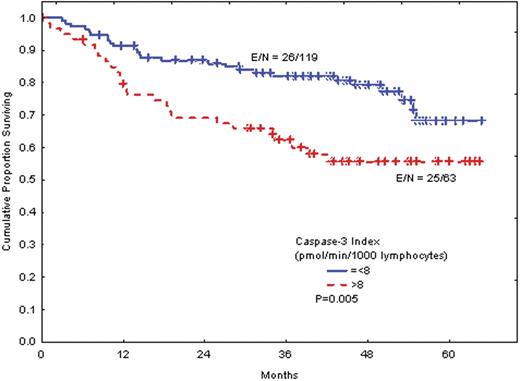Abstract
Abstract 4381
Because of the accumulation of lymphocytes and relative paucity of proliferating cells characteristic of B-cell chronic lymphocytic leukemia (CLL), defective apoptosis has been proposed as a key step in the pathogenesis of this disease. Activity levels of the proapoptotic enzyme caspase-3 have been used as a simple, quantitative measure of ongoing apoptosis in various cancers. Here we explored the clinical value of assessing apoptosis levels in patients with CLL, using caspase-3 activity in plasma as a surrogate marker for apoptosis. The study included 194 patients with CLL and 96 normal control subjects. Caspase-3 activity was measured in plasma samples by incubation with the substrate DEVD. Circulating caspase-3 activity was detectable in the plasma of all CLL patients and normal control subjects, but was significantly (P=0.005) lower in CLL patients (median=7.49; range=4.2-19.68 pmol/min/μL) than in controls (median=8.27; range=4.54-34.30 pmol/min/ul. Absolute levels of caspase-3 levels in plasma in CLL did not correlate with any of the laboratory variables examined (WBC, platelets, HGB, B2M), Rai stage, or performance status. To assess the extent of apoptosis in relevance to level of the disease or tumor load, the caspase-3 index was calculated by normalizing plasma caspase-3 activity to the number of circulating lymphocytes in peripheral blood. The circulating caspase-3 index correlated negatively with bone marrow cellularity (P<0.001), spleen size (P= 0.002), and number of sites of enlarged lymph nodes (P<0.001). Interestingly, the circulating caspase-3 index correlated positively with Rai stage (P=0.03, Kruskal-Wallis) but not IgVH mutation status (P=0.74) or performance status (p=0.72). More importantly, higher circulating caspase-3 index values (>8 pmol/min/1000 lymphocytes/ul) were significantly associated with poor overall survival (P=0.005). However, in multivariate analysis incorporating caspase-3 index along with beta-2 microglobulin level and IgVH mutation status showed that caspase-3 was not predictor of survival (p=0.7). In conclusion, apoptosis as determined using plasma caspase-3 activity is low in CLL. However, high circulating caspase-3 activity index values appear to reflect more aggressive disease. Further studies are needed to explore the possibility that this circulating caspase-3 index reflects the proportion of cells that are transformed into larger cells, with consequently higher proliferation and apoptosis rates, in patients with CLL.
No relevant conflicts of interest to declare.
Author notes
Asterisk with author names denotes non-ASH members.


This feature is available to Subscribers Only
Sign In or Create an Account Close Modal